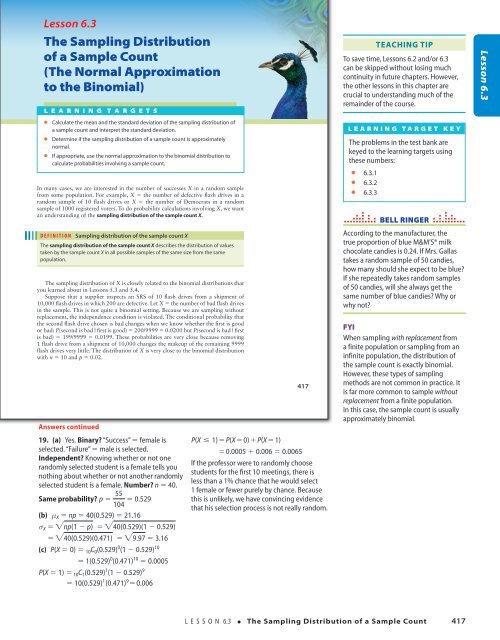SPA 3e_ Teachers Edition _ Ch 6
You also want an ePaper? Increase the reach of your titles
YUMPU automatically turns print PDFs into web optimized ePapers that Google loves.
18/08/16 5:00 PMStarnes_<strong>3e</strong>_CH06_398-449_Final.indd 417<br />
Lesson 6.3<br />
The Sampling Distribution<br />
of a Sample count<br />
(The normal Approximation<br />
to the Binomial)<br />
L e A r n i n g T A r g e T S<br />
d Calculate the mean and the standard deviation of the sampling distribution of<br />
a sample count and interpret the standard deviation.<br />
d Determine if the sampling distribution of a sample count is approximately<br />
normal.<br />
d If appropriate, use the normal approximation to the binomial distribution to<br />
calculate probabilities involving a sample count.<br />
In many cases, we are interested in the number of successes X in a random sample<br />
from some population. For example, X 5 the number of defective flash drives in a<br />
random sample of 10 flash drives or X 5 the number of Democrats in a random<br />
sample of 1000 registered voters. To do probability calculations involving X, we want<br />
an understanding of the sampling distribution of the sample count X.<br />
DEFINITION Sampling distribution of the sample count X<br />
The sampling distribution of the sample count X describes the distribution of values<br />
taken by the sample count X in all possible samples of the same size from the same<br />
population.<br />
The sampling distribution of X is closely related to the binomial distributions that<br />
you learned about in Lessons 5.3 and 5.4.<br />
Suppose that a supplier inspects an SRS of 10 flash drives from a shipment of<br />
10,000 flash drives in which 200 are defective. Let X 5 the number of bad flash drives<br />
in the sample. This is not quite a binomial setting. Because we are sampling without<br />
replacement, the independence condition is violated. The conditional probability that<br />
the second flash drive chosen is bad changes when we know whether the first is good<br />
or bad: P(second is bad | first is good) 5 200/9999 5 0.0200 but P(second is bad | first<br />
is bad) 5 199/9999 5 0.0199. These probabilities are very close because removing<br />
1 flash drive from a shipment of 10,000 changes the makeup of the remaining 9999<br />
flash drives very little. The distribution of X is very close to the binomial distribution<br />
with n 5 10 and p 5 0.02.<br />
Answers continued<br />
19. (a) Yes. Binary? “Success” 5 female is<br />
selected. “Failure” 5 male is selected.<br />
Independent? Knowing whether or not one<br />
randomly selected student is a female tells you<br />
nothing about whether or not another randomly<br />
selected student is a female. Number? n 5 40.<br />
Same probability? p = 55<br />
104 = 0.529<br />
(b) m X = np = 40(0.529) = 21.16<br />
s X = "np(1 − p) = "40(0.529)(1 − 0.529)<br />
= "40(0.529)(0.471) = "9.97 = 3.16<br />
(c) P(X = 0) = 10 C 0 (0.529) 0 (1 − 0.529) 10<br />
= 1(0.529) 0 (0.471) 10 = 0.0005<br />
P(X = 1) = 10C 1 (0.529) 1 (1 − 0.529) 9<br />
= 10(0.529) 1 (0.471) 9 = 0.006<br />
417<br />
18/08/16 5:00 PM<br />
P(X ≤ 1) = P(X = 0) + P(X = 1)<br />
= 0.0005 + 0.006 = 0.0065<br />
If the professor were to randomly choose<br />
students for the first 10 meetings, there is<br />
less than a 1% chance that he would select<br />
1 female or fewer purely by chance. Because<br />
this is unlikely, we have convincing evidence<br />
that his selection process is not really random.<br />
Teaching Tip<br />
To save time, Lessons 6.2 and/or 6.3<br />
can be skipped without losing much<br />
continuity in future chapters. However,<br />
the other lessons in this chapter are<br />
crucial to understanding much of the<br />
remainder of the course.<br />
Learning Target Key<br />
The problems in the test bank are<br />
keyed to the learning targets using<br />
these numbers:<br />
d 6.3.1<br />
d 6.3.2<br />
d 6.3.3<br />
BELL RINGER<br />
According to the manufacturer, the<br />
true proportion of blue M&M’S® milk<br />
chocolate candies is 0.24. If Mrs. Gallas<br />
takes a random sample of 50 candies,<br />
how many should she expect to be blue?<br />
If she repeatedly takes random samples<br />
of 50 candies, will she always get the<br />
same number of blue candies? Why or<br />
why not?<br />
FYI<br />
When sampling with replacement from<br />
a finite population or sampling from an<br />
infinite population, the distribution of<br />
the sample count is exactly binomial.<br />
However, these types of sampling<br />
methods are not common in practice. It<br />
is far more common to sample without<br />
replacement from a finite population.<br />
In this case, the sample count is usually<br />
approximately binomial.<br />
Lesson 6.3<br />
L E S S O N 6.3 • The Sampling Distribution of a Sample Count 417<br />
Starnes_<strong>3e</strong>_ATE_CH06_398-449_v3.indd 417<br />
11/01/17 3:54 PM




